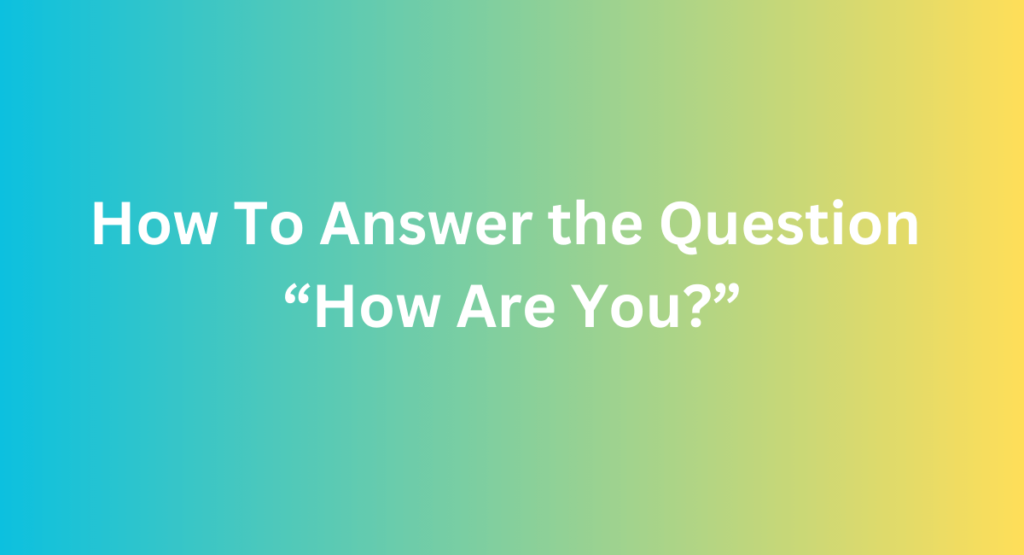
Great to hear! How’s everything else going?
When someone says “I’m fine,” it can sometimes be a polite way to deflect deeper conversation. They might not want to share more at that moment, or they genuinely feel okay. Responding with a brief, encouraging reply shows you care without prying.
This approach respects their boundaries while keeping the lines of communication open. You can follow up with another casual question to continue the conversation. This makes the interaction feel natural and supportive. Keep the tone light and friendly to create a comfortable atmosphere. This way, you show empathy and genuine interest in their well-being.
Understanding The Situation
When someone says “I’m fine,” it often leaves you wondering if they really mean it. Understanding the situation is crucial to offer the right support. This section will help you decode the phrase “I’m fine” and respond appropriately.
The Context Of The Conversation
The context of the conversation plays a significant role in understanding what “I’m fine” means. Here are some factors to consider:
- Time and Place: Is the person at work or home? The setting can affect their response.
- Body Language: Are they smiling or avoiding eye contact? Non-verbal cues can provide more insight.
- Past Interactions: Have they been open with you before? This can hint at their current emotional state.
Consider these scenarios:
| Scenario | Possible Meaning |
|---|---|
| At a busy workplace | They might be stressed but unwilling to discuss it. |
| During a casual chat with a close friend | They might be more willing to open up. |
| After a recent argument | They could be masking their true feelings. |
Understanding the context helps you gauge whether to dig deeper or give them space. Ask open-ended questions like, “Do you want to talk about it?” or “Is there something on your mind?”
Significance Of ‘i’m Fine’
The phrase “I’m fine” can have multiple meanings. It often depends on the individual’s emotional state and personality. Here are some interpretations:
- Deflection: They might be trying to avoid discussing their feelings.
- Politeness: They could be saying it to avoid burdening you with their problems.
- Denial: They might not be ready to acknowledge their emotions.
Consider these emotional cues:
| Emotional Cue | Possible Interpretation |
|---|---|
| Smiling but eyes look sad | They might be hiding their true feelings. |
| Quick response, no eye contact | They might be uncomfortable discussing their emotions. |
| Long pause before answering | They might be contemplating whether to open up. |
Understanding the significance of “I’m fine” helps you decide how to respond. You could say, “I’m here if you need to talk” or “It’s okay to not be okay.”
Common Responses
When someone says “I’m fine,” it can be hard to know how to respond. They might not be okay but don’t want to talk about it. Knowing common responses can help you show you care. Here are some ways to answer that show empathy and ask gentle questions.
Empathetic Statements
Empathetic statements show you care and understand their feelings. They make the other person feel heard and valued. Here are some ways to respond:
- “I understand.” This shows you are listening.
- “I’m here for you.” This lets them know they are not alone.
- “It’s okay to feel that way.” This validates their emotions.
- “Take your time.” This allows them to open up when they are ready.
Using empathetic statements can help build trust. They show you are a caring and supportive friend. Here is a table with more empathetic phrases:
| Empathetic Phrase | Meaning |
|---|---|
| “That sounds tough.” | Shows you understand their struggle. |
| “I’m here to listen.” | Encourages them to share more. |
| “You are not alone.” | Assures them of your support. |
| “It’s okay to talk about it.” | Gives them permission to express feelings. |
Probing Questions
Probing questions can help the person open up more. They show you are interested in how they really feel. Here are some questions to ask:
- “Do you want to talk about it?” This invites them to share more.
- “What’s been going on lately?” This shows you care about their life.
- “Is there something on your mind?” This lets them know you are there to listen.
- “How can I help?” This offers your support in a direct way.
Probing questions need to be gentle and respectful. They should not make the person feel pressured. Here are some more examples:
- “Would you like to grab a coffee and talk?” This suggests a relaxed setting for a chat.
- “How are you really feeling?” This encourages honesty.
- “Is there anything you want to get off your chest?” This invites them to share burdens.
- “Can I do anything to make it better?” This shows your willingness to help.
Using probing questions can help the person feel comfortable. They might open up more and share their true feelings. This can strengthen your relationship and provide them with the support they need.
Expressing Concern
When someone says “I’m fine,” it can be hard to know what to say next. Often, they might not be fine at all. Expressing concern shows that you care about their well-being. It can help open up meaningful conversations and provide the support they need.
Acknowledge Their Feelings
When someone tells you “I’m fine,” start by acknowledging their feelings. This shows that you are listening and that their emotions matter to you. Use phrases like:
- “I hear you.”
- “It’s okay to feel that way.”
- “Thank you for sharing.”
These responses validate their feelings and make them feel heard. Avoid jumping to conclusions or offering solutions immediately. Instead, give them space to share more if they want to.
Here are some more ways to acknowledge their feelings:
| Response | When to Use |
|---|---|
| “You seem a bit off today.” | If they look upset or tired. |
| “I can see this is hard for you.” | If they seem stressed or overwhelmed. |
| “It’s okay to not be okay.” | If they are struggling to open up. |
Remember, the goal is to make them feel comfortable and supported. Genuine concern can make a big difference.
Offer Supportive Words
After acknowledging their feelings, offer supportive words. Let them know you are there for them. Here are some examples:
- “I’m here for you.”
- “You don’t have to go through this alone.”
- “Is there anything I can do to help?”
These phrases show that you are willing to support them. They encourage the person to share more and seek help if needed.
Offering supportive words can also include:
| Supportive Phrase | Why It’s Effective |
|---|---|
| “Take your time.” | Gives them space to process their thoughts. |
| “I’m just a call away.” | Shows you are available anytime. |
| “Let’s talk when you’re ready.” | Respects their pace and comfort level. |
Offering support doesn’t mean you have to fix their problems. Sometimes, being a good listener and offering a shoulder to lean on is enough. Your concern and empathy can be powerful tools in helping someone feel better.
Encouraging Openness
Hearing someone say “I’m fine” can sometimes be a sign they aren’t actually fine. Encouraging openness can help them share their true feelings. Knowing the right way to respond can make a big difference. Here’s how you can encourage openness effectively.
Create A Safe Space
Creating a safe space is essential for someone to feel comfortable sharing their feelings. Here are some effective strategies:
- Listen actively: Show that you’re paying attention by nodding and maintaining eye contact.
- Be non-judgmental: Avoid making assumptions or passing judgment.
- Ask open-ended questions: Encourage them to elaborate, like “What’s been on your mind lately?”
Below is a table that shows the differences between a safe and an unsafe space:
| Safe Space | Unsafe Space |
|---|---|
| Active Listening | Interrupting |
| Non-Judgmental | Judgmental |
| Open-Ended Questions | Closed Questions |
Creating a safe space involves being patient and empathetic. Let them know that their feelings are valid and that you are there to support them. This encourages them to open up and share more freely.
Share Personal Experiences
Sharing personal experiences can help others feel less alone. It shows them that you understand what they might be going through. Here’s how you can do it:
- Be Authentic: Share your own feelings and experiences honestly.
- Be Relevant: Make sure your experience relates to what they are feeling.
- Be Brief: Keep your story short so the focus remains on them.
Consider the following example:
"I remember feeling the same way when I was dealing with [specific situation]. It really helped me to talk about it. How are you really feeling?"
By sharing your own story, you are not only showing empathy but also giving them the courage to share their own feelings. This helps build a deeper connection and fosters a sense of mutual support.
Remember, your goal is to make them feel heard and understood. Sharing personal experiences can break down barriers and create a more open and trusting dialogue.
Suggesting Alternatives
When someone says “I’m fine,” it might not always mean they are truly okay. It’s often a polite way to avoid deeper conversation. Suggesting alternatives can help you understand their feelings better and offer real support. Let’s explore some effective ways to respond.
Offer Specific Help
Instead of asking general questions, offer specific help. This shows you care and are ready to assist. Here are some ideas:
- Cooking a meal: “Can I bring you dinner tonight?”
- Running errands: “Need help with groceries or chores?”
- Listening ear: “Would you like to talk about what’s on your mind?”
Another way is to propose practical solutions:
| Situation | Offer |
|---|---|
| Feeling overwhelmed | “Can I help you prioritize tasks?” |
| Struggling with work | “Want me to review your project?” |
| Lonely | “Would you like to hang out this weekend?” |
Offering specific help can make a big difference. It shows you’re attentive and ready to support in meaningful ways.
Suggest Engaging Activities
Suggesting engaging activities can also uplift someone’s mood. Here are some fun ideas:
- Outdoor activities: “How about a walk in the park?”
- Creative hobbies: “Want to try painting together?”
- Fitness routines: “Join me for a yoga session?”
Consider planning something exciting:
- Game night: “Let’s play board games this Friday.”
- Movie marathon: “How about a movie night with your favorite films?”
- Cooking class: “Interested in a cooking class together?”
Engaging activities can be a great way to distract from stress. They also provide a chance to bond and create happy memories.
These suggestions can help show your concern and provide a meaningful way to support someone.
Normalizing Emotional Struggles
When someone says “I’m fine,” it often hides deeper feelings. Normalizing emotional struggles means recognizing everyone’s emotions. It’s important to create a safe space for open conversations. This helps in breaking the stigma around mental health.
Break The Stigma
Many people feel ashamed to talk about their feelings. This shame creates a stigma around emotional struggles. To break the stigma, we need to show empathy and understanding.
Here are some ways to help:
- Listen actively: Pay full attention when someone talks. This shows you care.
- Avoid judgment: Never judge someone’s feelings. Everyone experiences emotions differently.
- Share your own experiences: Talk about your feelings too. This makes others feel less alone.
- Encourage professional help: Suggest talking to a therapist. It’s a sign of strength, not weakness.
It’s also important to use positive language. Words can either help or hurt. Choose words that support and uplift. Avoid phrases like “get over it” or “you’re overreacting”. Instead, say things like “I’m here for you” or “Your feelings are valid”.
Discuss Mental Health
Talking about mental health should be as normal as talking about physical health. Discussing mental health can help remove the fear and shame that many feel.
Here are some tips for discussing mental health:
- Start the conversation: Ask open-ended questions like “How have you been feeling lately?”
- Be patient: Give the person time to open up. Don’t rush them.
- Show empathy: Use phrases like “That sounds really hard” or “I can see why you’re upset”.
- Offer support: Ask how you can help. Sometimes just being there is enough.
Creating a supportive environment is crucial. This includes schools, workplaces, and homes. Everyone should feel safe to express their feelings. Educating others about mental health is key. This can be done through workshops, seminars, and open discussions.
Here is a simple table to highlight the importance of discussing mental health:
| Benefits | Impact |
|---|---|
| Reduces Stigma | People feel less ashamed |
| Encourages Seeking Help | More people get the support they need |
| Improves Relationships | Better communication and understanding |
Being Mindful Of Boundaries
When someone says “I’m fine,” it can be tricky to know how to respond. It’s important to be mindful of their boundaries. Respecting their space and emotional state ensures a positive interaction. This blog post will guide you on how to handle such situations with care.
Respect Their Privacy
Respecting someone’s privacy is crucial. Not everyone is comfortable sharing their feelings. Here are some ways to respect their privacy:
- Acknowledge their response: You can simply say, “Okay, if you ever want to talk, I’m here.”
- Avoid prying: Don’t ask too many questions. It might make them uncomfortable.
- Give them space: Sometimes, people need time alone to process their emotions.
Here is a table to summarize the do’s and don’ts:
| Do’s | Don’ts |
|---|---|
| Acknowledge their feelings | Ask too many questions |
| Offer support | Push them to talk |
| Give space | Invade privacy |
Avoid Pushing Them
Pushing someone to share can be counterproductive. It may lead to them shutting down or feeling pressured. Here are some tips to avoid pushing:
- Ask open-ended questions: Instead of “Why are you fine?” try “Is there anything you’d like to share?”
- Show empathy: Use phrases like “I understand” or “I’m here for you.”
- Be patient: Give them time. They might open up when they feel ready.
Consider these actions as positive ways to offer support:
- Listening: Sometimes, a listening ear is all they need.
- Reassuring: Let them know it’s okay to feel how they feel.
- Following up later: Check back with them after some time.
Seeking Professional Help
When someone says “I’m fine,” they might not always mean it. Sometimes, they need more help than they let on. Understanding how to respond effectively can make a difference. Seeking professional help is a crucial step in supporting them. Let’s explore how to recognize warning signs and encourage therapy or counseling.
Recognize Warning Signs
Recognizing warning signs is essential to know when someone needs professional help. Look for these signs:
- Changes in behavior: Notice if they act differently than usual.
- Withdrawal: They might avoid social interactions.
- Mood swings: Frequent mood changes can be a sign.
- Sleep issues: Trouble sleeping or oversleeping.
- Appetite changes: Eating too much or too little.
Pay attention to their words and actions. Here are more specific signs:
| Physical Symptoms | Emotional Symptoms |
|---|---|
| Frequent headaches | Feeling hopeless |
| Stomach aches | Excessive worry |
| Fatigue | Sudden anger |
These signs might indicate they need more than a friendly chat. Recognizing these warning signs early can help them get the support they need.
Encourage Therapy Or Counseling
Encouraging therapy or counseling can be a delicate task. Here are some tips to approach it:
- Choose the right moment: Find a quiet time to talk.
- Be supportive: Show empathy and understanding.
- Share your concern: Use “I” statements to express your worry.
- Provide information: Offer details about available services.
- Offer to help: Suggest going with them to their first session.
Here’s an example script:
"I’ve noticed you seem different lately, and I'm worried about you. I think talking to a therapist could help. I can help you find one and even go with you if you like."
Be patient and understanding. Respect their feelings and decisions. Sometimes, just knowing someone cares can make a big difference. Encouraging professional help can lead to better mental health and well-being.
Frequently Asked Questions
How Do I Respond To An Im Fine Text?
Ask something specific about their day or feelings. For example, “What have you been up to? ” Or “Anything exciting happening? ” This shows genuine interest.
How Do You Respond To I’m Doing Fine?
That’s great to hear! How’s your day been so far?
How Do You React When Someone Says They Are Fine?
Acknowledge their response with a smile or nod. Ask a follow-up question to show genuine interest and concern.
What If Someone Says I’m Fine?
They might be avoiding deeper discussion. Respect their space but offer support if needed. Check in later gently.
Conclusion
Understanding how to respond when someone says “I’m fine” can strengthen your relationships. Showing genuine care and empathy makes a difference. Keep these tips in mind to foster deeper connections. Remember, a thoughtful reply can make someone feel truly heard and valued.
So, next time, think before you respond.


